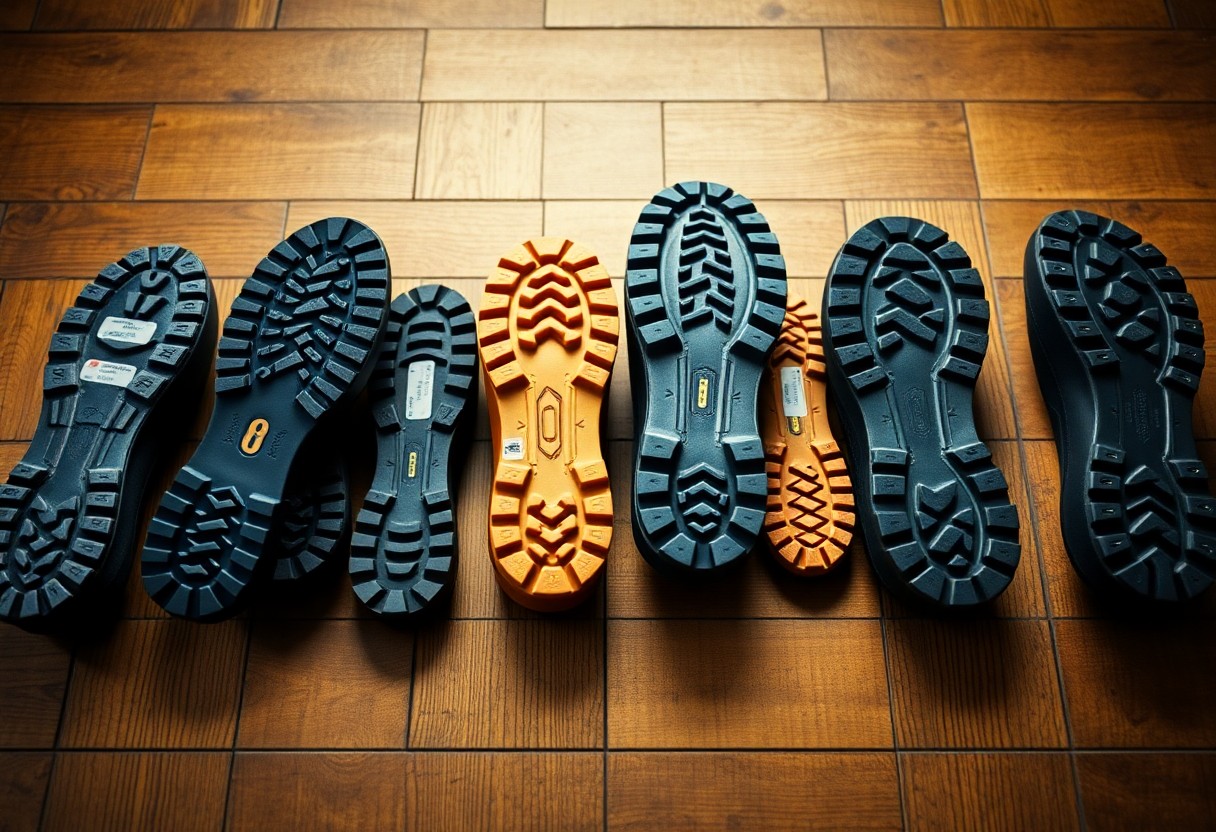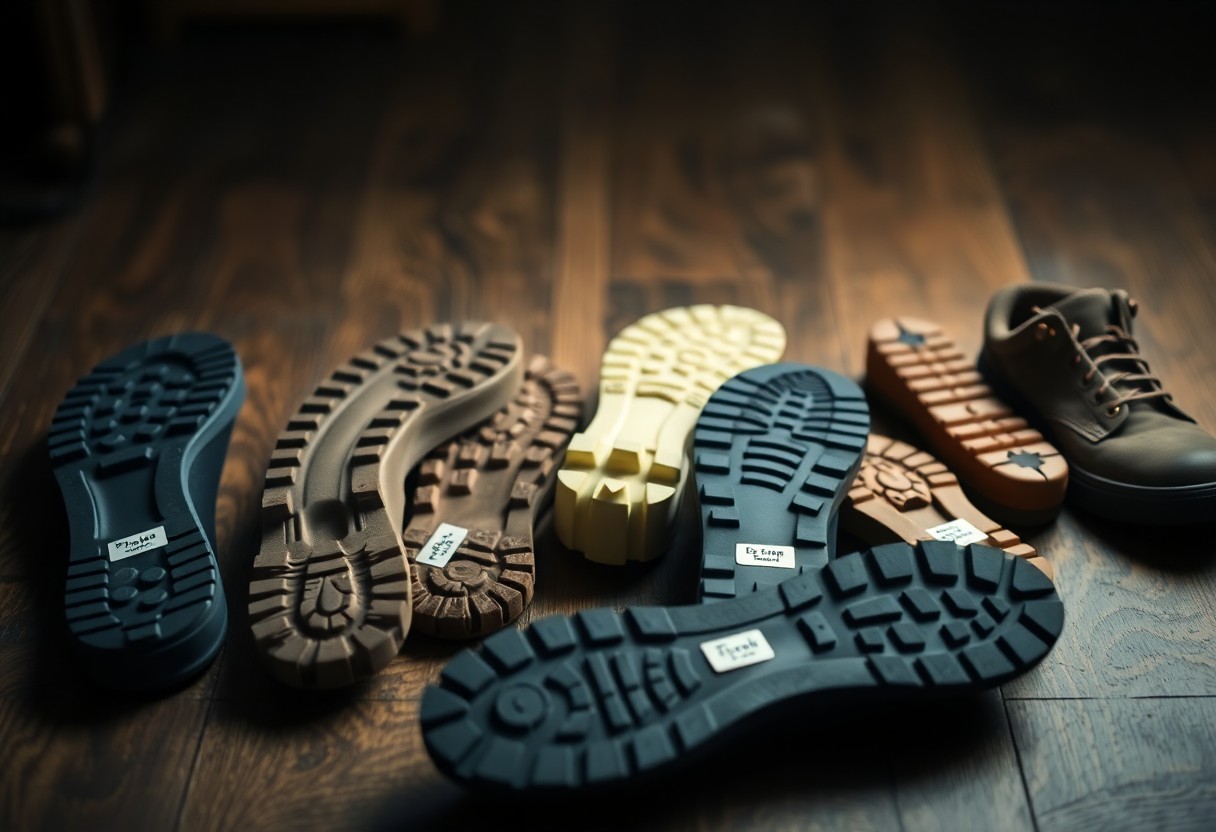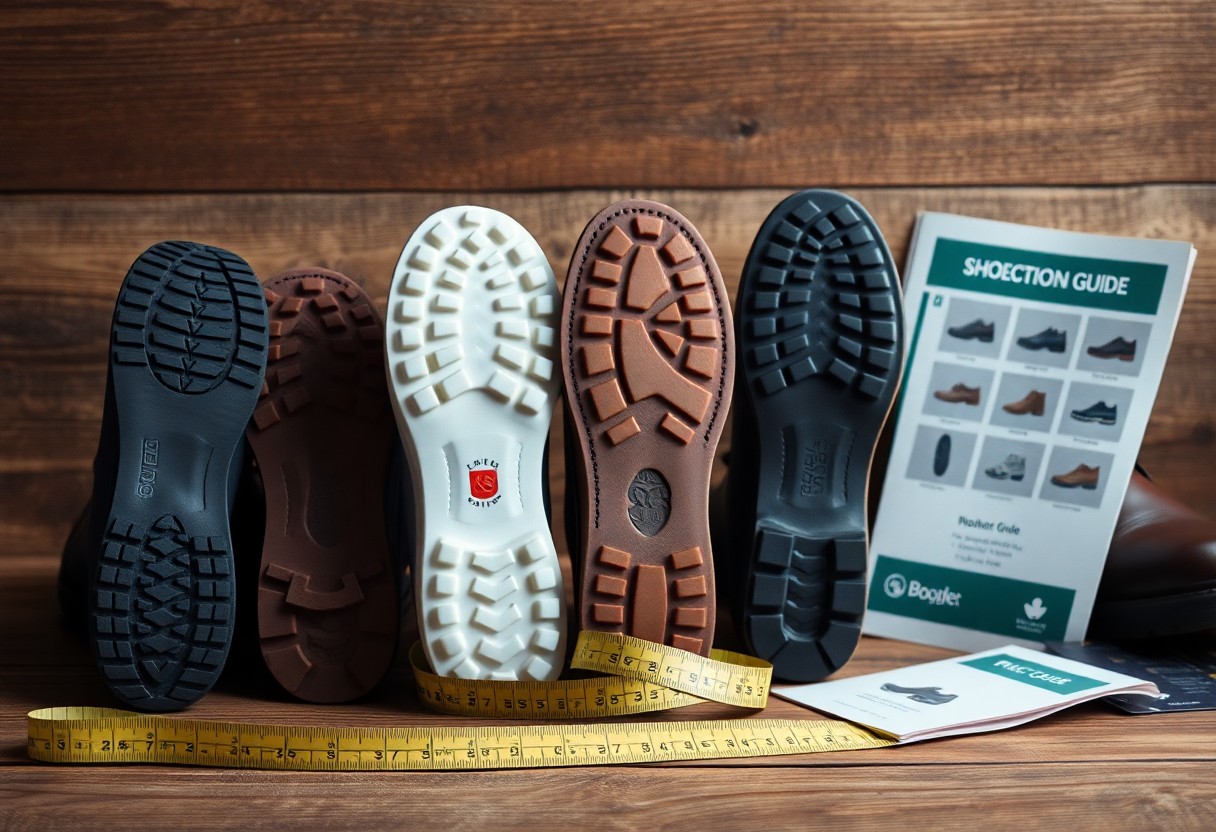
When choosing the right footwear, many individuals often overlook the crucial importance of shoe soles. This fundamental component greatly affects your overall comfort and safety while walking. The type of sole you select can significantly influence your ability to achieve stable footing on slippery surfaces and enjoy long-lasting comfort versus facing quick wear and tear. From traditional leather soles to advanced rubber compounds, every sole type offers specific benefits tailored for different purposes. Options include single leather, double leather, rubber, and hybrid soles, each meticulously designed for varying conditions and uses. This detailed guide aims to clarify the defining features of each sole type and help you choose the ideal option for your unique needs, whether you’re seeking footwear for professional environments, casual outings, or outdoor adventures.

Unlock the Benefits of Leather Soles for Enhanced Footwear Performance
Your choice of leather soles can dramatically influence both the style and functionality of your footwear. These classic soles are celebrated for their superior breathability and natural comfort, molding to the unique contours of your feet over time. This adaptability provides a personalized fit that greatly enhances your walking experience. While leather soles require more maintenance than synthetic options, they offer excellent ground feel, making them particularly suitable for formal occasions where elegance is key. Gaining insight into the numerous benefits of leather soles can empower you to make an informed selection that not only enriches your wardrobe but also elevates your daily walking experience.
Embrace Timeless Elegance with Single Leather Soles for Dress Shoes
Soles made from a single layer of leather represent the classical choice for sophisticated dress shoes. These soles are designed to provide exceptional flexibility while maintaining a polished appearance, enhancing your style for formal events and gatherings. Although they offer better breathability than rubber options, caution is advised when navigating wet environments to avert potential damage and slips. By opting for single leather soles, you embrace a refined aesthetic while benefiting from the comfort that stems from high-quality craftsmanship and a traditional design that remains timeless.
Enhance Footwear Longevity with Double Leather Soles
Double leather soles, featuring two layers of leather, provide you with improved durability and superior insulation against cold surfaces, making them an outstanding choice for various climates. Although they may feel slightly stiffer than single soles, they offer enhanced protection for your feet, ensuring comfort during prolonged wear. This design guarantees that double leather soles will significantly outlast their single counterparts, making them a wise investment for everyday use. They’re particularly ideal for individuals with a heavier build or those frequently engaged in outdoor activities, although they do necessitate a longer break-in period to reach optimal comfort and performance.
By choosing double leather soles, you are selecting a solution that merges durability and performance, ensuring your footwear withstands the rigors of daily use while maintaining a stylish look that complements any outfit.
Maximize Footwear Efficiency with HAF (Half and Full) Soles
HAF soles, which combine single leather in the waist and heel with double leather in the forepart, provide you with the best of both worlds. This innovative design guarantees that you receive extra durability in high-wear areas while maintaining a sleek and elegant profile suitable for various occasions. The unique construction of HAF soles also facilitates balanced weight distribution and enhanced comfort, effectively protecting areas subject to wear without compromising the shoe’s refined appearance. However, it’s crucial to ensure your cobbler incorporates suitable heel compensation to achieve optimal balance and stability, further enhancing your walking experience.
Explore the Versatility of Natural and Mixed Soles for Everyday Footwear
Natural and mixed soles present a well-rounded blend of comfort and durability. These soles integrate organic materials such as cork, natural rubber, or leather with synthetic compounds to create adaptable and high-performing footwear solutions that cater to a variety of lifestyles. When selecting among the various natural and mixed soles, consider your specific requirements for grip, weight, and resistance to weather conditions. Grasping these factors will aid you in making an informed decision that aligns with your lifestyle and activities, ensuring your footwear meets your expectations in every situation.
Experience Lightweight Comfort with Nitrile Cork Soles
Nitrile cork soles offer a lightweight alternative to traditional rubber options while maintaining exceptional durability without the burden of extra weight. These soles, which combine cork with nitrile rubber, are 30% lighter than standard rubber soles, making them a preferred choice for American shoes and boots where comfort is paramount for daily use. Available in both smooth and treaded patterns, nitrile cork soles are perfect for those prioritizing lightweight footwear while still demanding performance. Choosing these soles allows you to engage in daily activities with ease and style, ensuring each step feels great.
Enjoy Casual Comfort and Style with Natural Crepe Soles
Natural crepe soles, made from pure rubber, provide exceptional comfort through their soft, cushioning properties, making them ideal for casual footwear. These soles offer varying levels of grip depending on the surface conditions, enhancing your overall walking experience. While crepe soles deliver superior comfort for everyday wear, they also come with limitations. Their soft composition leads to a wear rate that is approximately 40% faster than conventional rubber soles, and their grip may fluctuate on wet surfaces. Therefore, while many users appreciate the comfort they provide, it’s vital to consider the likelihood of needing more frequent replacements to maintain optimal performance.

Discover the Unique Advantages of Rubber Soles for All-Weather Performance
When it comes to shoes and boots, rubber soles are distinguished by their superior grip and water resistance compared to leather counterparts. These soles are particularly beneficial in wet conditions, making them an excellent choice for everyday wear in diverse weather scenarios. Rubber soles provide excellent durability and require less maintenance than leather options; however, they may feel warmer on your feet during the hotter summer months. The practical benefits of rubber soles make them a wise choice for individuals seeking reliable performance and comfort in their footwear choices.
Achieve a Perfect Balance of Style and Function with Rubber Topy Soles
Rubber Topy soles present an excellent compromise between leather and rubber soles, offering you the best of both worlds. You gain the classic look of leather soles while enjoying improved grip and durability, which is essential for various activities. A thin rubber layer is affixed to a slightly sanded leather sole, effectively extending the lifespan of your footwear by up to 50%. This combination allows you to relish the aesthetic appeal of leather without sacrificing functionality, making Rubber Topy soles a smart investment for your footwear collection that balances style with practicality.
Experience Unmatched Style and Functionality with City Rubber Soles
By opting for city rubber soles, you achieve a sophisticated dress shoe appearance without sacrificing practicality or comfort. These thin rubber soles closely mimic traditional leather soles while providing better traction and waterproofing, making them suitable for various urban settings. Gaining popularity in modern dress shoes, city rubber soles not only enhance the visual allure of your footwear but also improve longevity compared to leather soles, necessitating less frequent resoling. Ideal for urban environments, these soles can adeptly handle concrete sidewalks and incidental rain, ensuring you remain stylish and comfortable in any circumstance.
Optimize Footwear Durability with Dainite and Studded Soles
Among rubber options, Dainite and studded soles deliver maximum durability and grip. Their unique studded pattern guarantees reliable traction while retaining a formal appearance, making them particularly suitable for business casual footwear and dress boots. While Dainite soles are highly resistant to wear, it’s essential to recognize that they can become slippery in freezing temperatures. User experiences may vary, as some find them firmer than other sole types. However, for everyday use in moderate conditions, these soles generally outlast traditional leather soles by two to three times, making them an excellent choice for enduring performance that withstands the test of time.
Essential Performance Features of Shoe Soles You Need to Know
Your choice of shoe sole significantly impacts your daily comfort and safety. Different types of soles provide varying levels of grip, shock absorption, and flexibility, each serving specific functions, from preventing slips on wet surfaces to alleviating foot fatigue during prolonged walking. Understanding these performance features will guide you in selecting the right sole type for your needs, enhancing your overall footwear experience and ensuring your feet feel great throughout the day.
Evaluate Durability Factors in Sole Materials for Smart Choices
The lifespan of different sole materials can vary widely in terms of wear resistance. Generally, rubber compounds outlast leather soles by three to four times, while nitrile cork serves as a middle ground. Factors such as material density and tread pattern are crucial in determining the longevity of your soles. Being aware of these durability factors empowers you to make cost-effective footwear choices tailored to your specific lifestyle, ensuring you invest in soles that meet your demanding requirements.
Understand Weather Resistance for Optimal Sole Performance
Critical factors like water resistance, temperature tolerance, and traction are essential in determining how your soles perform under various conditions. Typically, rubber soles provide superior grip in wet situations, while leather soles excel in dry environments due to their unique properties. It’s important to keep in mind that temperature fluctuations can greatly affect sole performance. Certain rubber compounds may become dangerously hard in freezing temperatures, while others retain their flexibility. Your local climate should guide your selection: city rubber soles are optimal for mild wet conditions, while specialized winter soles enhance safety in snowy or icy environments, ensuring you make wise choices suited to your climate.

Your Comprehensive Guide to Selecting the Perfect Shoe Sole
Recognizing that not all shoe soles are created equal is crucial; your selection should align with your unique needs and preferences. The right sole type can profoundly affect your comfort, safety, and the durability of your footwear. This guide is crafted to assist you in selecting the most appropriate sole type based on your lifestyle, activities, and environmental conditions, ensuring you make choices that genuinely benefit your everyday life.
Consider Your Daily Activities to Choose the Right Sole
When selecting a sole, essential factors to contemplate include your daily activities and the walking surfaces you frequently encounter. For office environments, thin leather or city rubber soles are suitable to maintain a polished appearance. Conversely, industrial settings benefit from thicker rubber or studded soles that provide enhanced protection and slip resistance. For outdoor activities, it’s critical to focus on grip requirements and durability needs to ensure safety and comfort. Understanding your primary usage will help you narrow down the best available options, allowing you to make informed footwear choices.
Evaluate Climate Factors for Optimal Sole Performance
In addition to weather conditions, variations in temperature can significantly influence the performance of shoe soles. Here are some key considerations:
- Wet conditions – rubber soles provide superior grip and stability.
- Cold weather – thicker soles offer better insulation against the chill.
- Hot climates – breathable leather soles keep feet cool.
- Variable weather – hybrid soles deliver versatility for changing conditions.
Understanding your local climate patterns is essential for selecting the most suitable sole type for your footwear, ensuring you remain comfortable regardless of the weather.
Moreover, it’s vital to consider how different sole materials react to various weather conditions:
- Leather soles require special care in wet environments to maintain their integrity.
- Rubber soles become very hard below 0°C, affecting performance.
- Nitrile cork offers a good balance in moderate conditions for daily use.
- City rubber soles provide year-round versatility for urban living.
Being aware of these characteristics ensures your footwear will perform adeptly in any season, providing the comfort and support you deserve.
Essential Maintenance and Care for Shoe Sole Longevity
To guarantee the longevity and performance of your shoe and boot soles, routine maintenance is crucial. The lifespan of your soles is greatly influenced by proper care, which includes cleaning, drying, and protective treatments. Each sole material demands specific care requirements; for instance, leather soles necessitate waterproofing to avert damage, while rubber soles benefit from regular removal of debris to sustain their grip.
Establish Effective Cleaning Methods for Your Footwear
A well-maintained sole begins with a consistent cleaning routine that preserves the integrity of your footwear. To achieve this, you should:
- Use a soft brush to gently remove dirt and debris.
- Clean with mild soap and water to avoid harsh chemicals.
- Apply specialized cleaners suitable for specific materials to maintain their quality.
- Ensure thorough drying after cleaning to prevent moisture damage.
Recognizing the appropriate cleaning methods for your particular sole type will help prevent damage and extend the lifespan of your footwear, allowing you to enjoy them for many years.
Implement Preservation Tips for Extended Sole Life
To enhance the durability of your soles, consider the following practical tips:
- Rotate your footwear daily to facilitate proper airing and limit wear.
- Utilize shoe trees while storing to maintain shape and prevent creasing.
- Apply protective sprays as necessary for added protection against the elements.
- Regularly inspect for wear patterns to identify signs of deterioration early.
By recognizing the early signs of wear, you can take proactive measures to prevent irreversible damage to your footwear, ensuring they remain in excellent condition for as long as possible.
It’s essential to note that preservation methods can differ significantly based on the sole type:
- Leather soles require waterproofing every 3-4 months to maintain their quality.
- Rubber soles should be routinely checked for cracks and wear.
- Cork soles need protection from moisture to avoid degradation.
- Crepe soles should be kept away from extreme heat to prevent damage.
Understanding the specific needs of your sole type ensures optimal maintenance and longevity of your footwear, helping you maximize your investment.
Make Informed Decisions for Your Footwear Needs
Your choice of shoe sole is crucial in determining your comfort and overall performance. It’s vital to align your sole type with your specific needs—whether you prefer leather soles for formal occasions or rubber variants for unpredictable weather. Considerations like your lifestyle, walking surfaces, and local climate should guide your selection process. For instance, a single leather sole provides elegance for dress shoes, while Dainite or city rubber soles enhance grip and durability, making them ideal for various environments. By gaining a comprehensive understanding of different sole types and their unique advantages, you can make informed footwear decisions that cater to your daily needs and preferences, ensuring your feet receive the support they require.
Frequently Asked Questions about Shoe Soles
Q: What are the main differences between leather and rubber soles?
A: Leather soles are recognized for their superior breathability and ability to conform to your feet over time, making them ideal for dress shoes. They perform excellently in dry conditions but require careful handling in wet weather to avoid damage. On the other hand, rubber soles provide better water resistance and grip, generally have a longer lifespan, and are suitable for various weather conditions. Additionally, rubber soles are often more affordable and require less upkeep than leather soles, making them a practical choice for everyday use.
Q: How do I choose the appropriate sole type to meet my daily needs?
A: To select the right sole type, consider your primary environments and activities. For formal office settings, opt for leather soles that exude elegance, while rubber soles are better suited for outdoor walking and wet conditions due to their superior grip. For versatile usage across different weather scenarios, studded soles like Dainite are an excellent choice, offering durability. For casual outings, crepe soles deliver high comfort but may wear out more rapidly. Match your sole type to your most frequent activities and environmental conditions to ensure optimal performance and comfort.
Q: What advantages do double soles have over single soles?
A: Single soles offer greater flexibility and a sleeker profile, making them ideal for dress shoes. In contrast, double soles are designed for enhanced durability and better insulation against cold and wet conditions. They are appropriate for casual shoes and boots but may require a more extended break-in period. While double soles can add some weight to the shoe, they also offer increased protection for challenging terrains, making them a wise choice for individuals in need of extra support.
The Article Guide to shoe and boot sole types features benefits and how to choose the right one appeared first on My Shoes Finder
The Article Shoe and Boot Sole Types: Features, Benefits, and Selection Tips Was Found On https://limitsofstrategy.com
The Article Shoe and Boot Sole Types: Essential Features and Selection Guide First Appeared ON
: https://ad4sc.com










Comments are closed